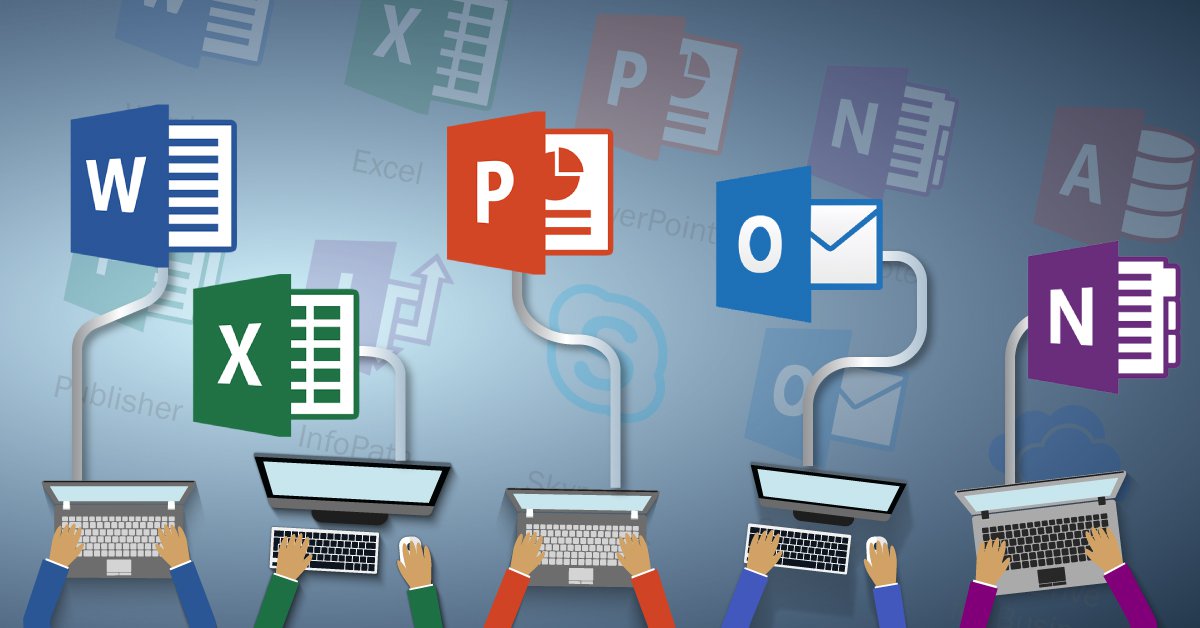Word 2016 is designed to help you create professional-quality documents. Word can also help you organize and write documents more efficiently.
When you create a document in Word, you can choose to start from a blank document or let a template do much of the work for you. From then on, the basic steps in creating and sharing documents are the same. And Word’s powerful editing and reviewing tools can help you work with others to make your document great.
Start a document
It’s often easier to create a new document using a template instead of starting with a blank page. Word templates come ready-to-use with pre-set themes and styles. All you need to do is add your content.
Each time you start Word, you can choose a template from the gallery, click a category to see more templates, or search for more templates online.
For a closer look at any template, click it to open a large preview.
If you’d rather not use a template, click Blank document.
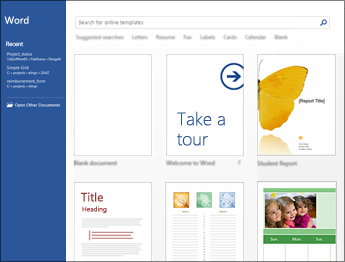
Open a document
Every time you start Word, you’ll see a list of your most recently used documents in the left column. If the document you’re looking for isn’t there, click Open Other Documents.
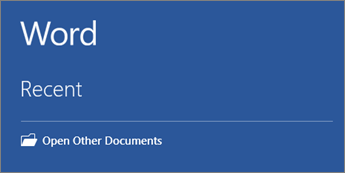
If you’re already in Word, click File > Open and then browse to the file’s location.
When you open a document that was created in earlier versions of Word, you see Compatibility Mode in the title bar of the document window. You can work in compatibility more or you can upgrade the document to use Word 2016.
Save a document
To save a document for the first time, do the following:
-
On the File tab, click Save As.
-
Browse to the location where you’d like to save your document.
Note: To save the document on your computer, choose a folder under This PC or click Browse. To save your document online, choose an online location under Save As or click Add a Place. When your files are online, you can share, give feedback and work together on them in real time.
-
Click Save.
Note: Word automatically saves files in the .docx file format. To save your document in a format other than .docx, click the Save as type list, and then select the file format that you want.
To save your document as you continue to work on it, click Save in the Quick Access Toolbar.
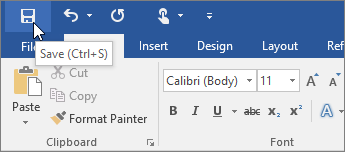
Read documents
Open your document in Read Mode to hide most of the buttons and tools so you can get absorbed in your reading without distractions.
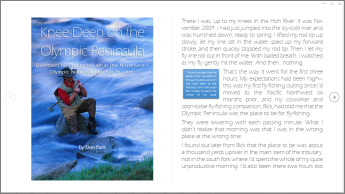
-
Open the document you want to read.
Note: Some documents open in Read Mode automatically, such as protected documents or attachments.
-
Click View > Read Mode.
-
To move from page to page in a document, do one of the following:
-
Click the arrows on the left and right sides of the pages.
-
Press page down and page up or the spacebar and backspace on the keyboard. You can also use the arrow keys or the scroll wheel on your mouse.
-
If you’re on a touch device, swipe left or right with your finger.
Tip: Click View > Edit Document to edit the document again.
-
Track changes
When you’re working on a document with other people or editing a document yourself, turn on Track Changes to see every change. Word marks all additions, deletions, moves, and formatting changes.
-
Open the document to be reviewed.
-
Click Review and then on the Track Changes button, select Track Changes.
Read Track changes to learn more.
Print your document
All in one place, you can see how your document will look when printed, set your print options, and print the file.
-
On the File tab, click Print.
-
Do the following:
-
Under Print, in the Copies box, enter the number of copies you want.
-
Under Printer, make sure the printer you want is selected.
-
Under Settings, the default print settings for your printer are selected for you. If you want to change a setting, just click the setting you want to change and then select a new setting.
-
-
When you’re satisfied with the settings, click Print.
For details, see Print a document.
Beyond the basics
For more on the fundamentals of using Word, see What’s new in Word 2016.
Top of Page
With Word for the web, you use your web browser to create, view, and edit the personal documents that you store on OneDrive. If your organization or college has a Microsoft 365 plan or SharePoint site, start using Word for the web by creating or storing documents in libraries on your site.Save changes
Word saves your changes automatically. Look on the status bar at the bottom left corner of Word for the web. It will either show Saved or Saving.

Share documents online
Because your document is online, you can share it by sending a link instead of an email attachment. People can read it in their web browser or mobile device.
Click File > Share > Share with People.
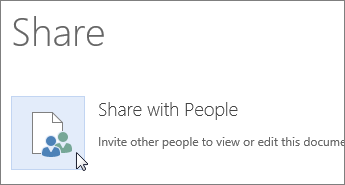
Comment in the browser
A comment balloon shows where comments have been made in the doc.
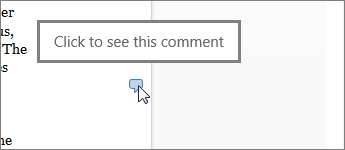
Reply to comments, and check off items you’ve addressed.
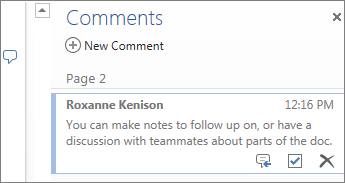
Edit in the browser
If you try to type in the document and nothing happens, you’re probably in Reading view. Switch to Editing view: click Edit Document > Edit in Word for the web.
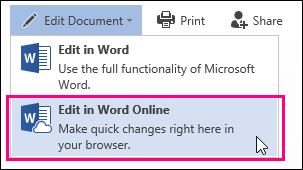
Type and format text, add pictures, adjust the layout of the page, and more. For more advanced editing, click Open in Word.
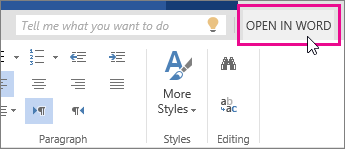
Work together on the same doc
To work together in Word for the web, you edit a document as you normally would. If others are also editing it, Word for the web alerts you to their presence. You can see everyone who is currently working in the document by clicking in the ribbon.
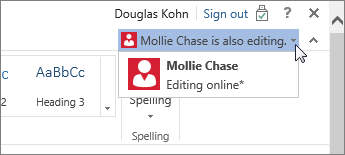
Clicking on an author’s name jumps you to where they’re working in the doc. And you’ll see the changes they make as they’re happening. They can be working in Word for the web, Word 2010 or later, or Word for Mac 2011.
Add a header or footer
Go to Insert > Header & Footer to add headers and footers to your document.
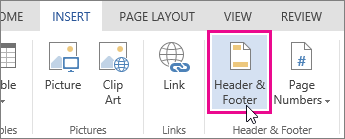
Click Options to choose how you’d like them to appear.

Add page numbers
Click Insert > Page Numbers and then choose from the gallery where you’d like the page numbers to appear.
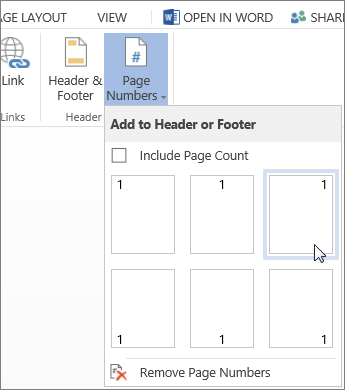
Select Include Page Count to show the current page number along with the total number of pages (page X of Y).
Find and replace text
Quickly search for every occurrence of a specific word or phrase in your document by clicking Home > Find (or type Ctrl+F). Results appear next to your document so you can see the term in context. Clicking on a search result jumps you to that occurrence.
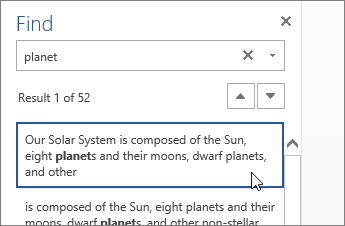
Click Replace (or type Ctrl+H) to find and replace text.
Print in Word for the web
Go to File > Print. Word for the web creates a PDF preview of your document that keeps all the layout and formatting of your document. Send the PDF to your printer and it will print the way you expect.
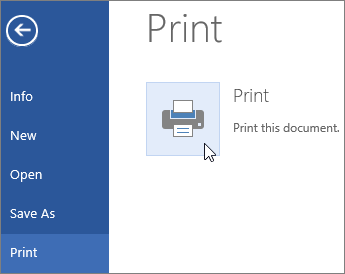
Microsoft Word 2013 is a word-processing program designed to help you create professional-quality documents. Word helps you organize and write your documents more efficiently.
Your first step in creating a document in Word 2013 is to choose whether to start from a blank document or to let a template do much of the work for you. From then on, the basic steps in creating and sharing documents are the same. Powerful editing and reviewing tools help you work with others to make your document perfect.
Choose a template
It’s often easier to create a new document using a template instead of starting with a blank page. Word templates are ready to use with themes and styles. All you need to do is add your content.
Each time you start Word 2013, you can choose a template from the gallery, click a category to see the templates it contains, or search for more templates online. (If you’d rather not use a template, just click the Blank document.)

For a closer look at any template, just click it to open a large preview.
Top of Page
Open a document
Every time you start Word, you’ll see a list of your most recently used documents in the left column. If the document you’re looking for isn’t there, click Open Other Documents.
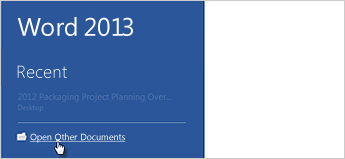
If you’re already in Word, click File > Open and then browse to the file’s location.
When you open a document that was created in earlier versions of Word, you see Compatibility Mode in the title bar of the document window. You can work in compatibility more or you can upgrade the document to use features that are new or enhanced in Word 2013.
Top of Page
Save a document
To save a document for the first time, do the following:
-
Click the File tab.
-
Click Save As.
-
Browse to the location where you’d like to save your document.
Note: To save the document on your computer, choose a folder under Computer or click Browse. To save your document online, choose a location under Places or Add a Location. When your files are online, you can share, give feedback and work together on them in real time.
-
Click Save.
Note: Word automatically saves files in the .docx file format. To save your document in a format other than .docx, click the Save as type list, and then select the file format that you want.
To save your document as you continue to work on it, click Save in the Quick Access Toolbar.
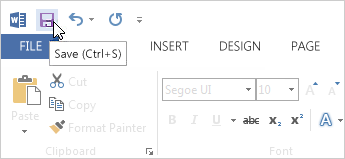
Top of Page
Read documents
Open your document in Read Mode to hide most of the buttons and tools so you can get absorbed in your reading without distractions.

-
Open the document you want to read.
Note: Some documents open in Read Mode automatically, such as protected documents or attachments.
-
Click View > Read Mode.
-
To move from page to page in a document, do one of the following:
-
Click the arrows on the left and right sides of the pages.
-
Press page down and page up or the spacebar and backspace on the keyboard. You can also use the arrow keys or the scroll wheel on your mouse.
-
If you’re on a touch device, swipe left or right with your finger.
Tip: Click View > Edit Document to edit the document again.
-
Top of Page
Track changes
When you’re working on a document with other people or editing a document yourself, turn on Track Changes to see every change. Word marks all additions, deletions, moves, and formatting changes.
-
Open the document to be reviewed.
-
Click Review and then on the Track Changes button, select Track Changes.

Read Track changes to learn more.
Top of Page
Print your document
All in one place, you can see how your document will look when printed, set your print options, and print the file.
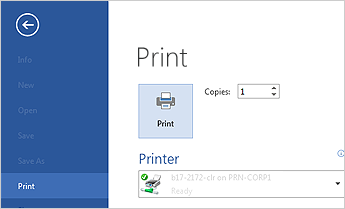
-
Click the File tab and then click Print.
-
Do the following:
-
Under Print, in the Copies box, enter the number of copies you want.
-
Under Printer, make sure the printer you want is selected.
-
Under Settings, the default print settings for your printer are selected for you. If you want to change a setting, just click the setting you want to change and then select a new setting.
-
-
When you’re satisfied with the settings, click Print.
For details, see Print and preview documents.
Beyond the basics
Go beyond the basics with your documents by creating a table of contents or saving a document as a template.
Top of Page
Important:
Office 2010 is no longer supported. Upgrade to Microsoft 365 to work anywhere from any device and continue to receive support.
Upgrade now
In this article
-
What is Word?
-
Find and apply a template
-
Create a new document
-
Open a document
-
Save a document
-
Read documents
-
Track changes and insert comments
-
Print your document
What is Word?
Microsoft Word 2010 is a word-processing program, designed to help you create professional-quality documents. With the finest document-formatting tools, Word helps you organize and write your documents more efficiently. Word also includes powerful editing and revising tools so that you can collaborate with others easily.
Top of Page
Find and apply a template
Word 2010 allows you to apply built-in templates, to apply your own custom templates, and to search from a variety of templates available on the web.
To find and apply a template in Word, do the following:
-
On the File tab, click New.
-
Under Available Templates, do one of the following:
-
To use one of the built-in templates, click Sample Templates, click the template that you want, and then click Create.
-
To reuse a template that you’ve recently used, click Recent Templates, click the template that you want, and then click Create.
-
To use your own template that you previously created, click My Templates, click the template that you want, and then click OK.
-
To find a template on Office.com, under Office.com Templates, click the template category that you want, click the template that you want, and click Download to download the template from Office.com to your computer.
-
Note: You can also search for templates on Office.com from within Word. In the Search Office.com for templates box, type one or more search terms, and then click the arrow button to search.
Top of Page
Create a new document
-
Click the File tab and then click New.
-
Under Available Templates, click Blank Document.
-
Click Create.
For more information about how to create a new document, see Create a document.
Top of Page
Open a document
-
Click the File tab, and then click Open.
-
In the left pane of the Open dialog box, click the drive or folder that contains the document.
-
In the right pane of the Open dialog box, open the folder that contains the drawing that you want.
-
Click the document and then click Open.
Top of Page
Save a document
To save a document in the format used by Word 2010 and Word 2007, do the following:
-
Click the File tab.
-
Click Save As.
-
In the File name box, enter a name for your document.
-
Click Save.
To save a document so that it is compatible with Word 2003 or earlier, do the following:
-
Open the document that you want to be used in Word 2003 or earlier.
-
Click the File tab.
-
Click Save As.
-
In the Save as type list, click Word 97-2003 Document. This changes the file format to .doc.
-
In the File name box, type a name for the document.
-
Click Save.
For more information about how to create a document that is compatible with Word 2003 or earlier versions, see Create a document to be used by previous versions of Word.
Top of Page
Read documents
-
Open the document that you want to read.
-
On the View tab, in the Document Views group, click Full Screen Reading
-
To move from page to page in a document, do one of the following:
-
Click the arrows in the lower corners of the pages.
-
Press PAGE DOWN and PAGE UP or SPACEBAR and BACKSPACE on the keyboard.
-
Click the navigation arrows at the top center of the screen.
Tip: Click View Options, and then click Show Two Pages
to view two pages, or screens, at a time.
-
For more information about how to view documents, see Read documents in Word.
Top of Page
Track changes and insert comments
-
To turn on change tracking, on the Review tab, in the Tracking group, click Track Changes.
-
To insert a comment, on the Review tab, in the Comments group, click New Comment.
For more information about how to track changes made while revising, see Track changes and insert comments.
Top of Page
Print your document
-
Click the File tab and then click Print.
-
Do the following:
-
Under Print, in the Copies box, enter the number of copies that you want to print.
-
Under Printer, make sure that the printer that you want is selected.
-
Under Settings, the default print settings for your printer are selected for you. If you want to change a setting, click the setting you want to change and then select the setting that you want.
-
-
When you are satisfied with the settings, click Print.
For more information about how to print a file, see Preview and print a file.
Top of Page
If you make any kind of document, you’ll want to consider Microsoft Word. This helpful tool helps to create a wide variety of professional documents quickly and easily. Now, Microsoft Word is a popular commercial word processor created by Microsoft. MS Word is also one of the widely used programs in the suite. There are many features of MS word. Although many other applications give it a competition, nothing has defeated it to date.
It is available for both Windows and Apple operating systems. Microsoft Word is in the Microsoft Office productivity package, although it is also available as a standalone application. Microsoft Word was first released in 1983 and has seen various revisions since then. It’s compatible with both Windows and Mac computers.
Features of MS word help to make professional write-ups, editing and formatting the existing documents. It also helps in creating graphical documents comprising images, and more. Millions of office workers, students and home users create, read and edit documents use this software program. It can also be useful to familiarize yourself with the basic features and characteristics of the application.
Also Read: Top 5 GTA 5 Like Games That You Can Play On Your Smartphone
This guide lets users who want to learn Microsoft Word basics but don’t have much experience with computers or Microsoft software. It will provide you with a solid foundation in MS Word, allowing you to progress to greater levels of proficiency.
Basics of Microsoft Word
You may use Microsoft Office Word to create and modify personal and business documents like letters, reports, invoices, emails, and books. Documents saved in Word are saved with the.docx extension by default.
Microsoft Word can be used for a variety of tasks:
- Creating business papers with a variety of images, such as photos, charts, and diagrams.
- Saving and reusing pre-formatted text and elements like cover pages and sidebars.
- Making letters and letterheads for both personal and professional use.
- Creating a variety of documents, including resumes and invitation cards.
- Producing a variety of letters, ranging from simple office memos to legal copies and reference documents.
Now, let us first understand some basic aspects of the application. You can open the application on your personal computer while following these simple steps:
Start → All Programs → MS Office → MS Word
Then, if you want to open a document,
Click on “New” on the left-hand side of the screen. This opens a screen where you can choose between a blank document, your old documents, and more.
Also Read: iPhone 13 Series Launched with A15 Bionic Chip: Price, Specs
List of Features of MS Word
Home
This feature of MS word has options like font colour, font size, font style, alignment, bullets, line spacing, etc. Additionally, all the basic elements that one may need to edit their document are available under the Home option.
Insert
You can enter tables, shapes, images, charts, graphs, header, footer, page number, etc., in the document. These Features of MS word are available in the “Insert” category.
Also Read: Complete List of GTA Vice City Cheat Codes for PC, PS4, Xbox
Design
You can create or select the template or the design under the Design Tab in which you want your document to be by using this Features of MS word. Moreover, choosing an appropriate tab will enhance the appearance of your document on MS Word.
Page Layout
This Features of MS word under the Page Layout tab come with options like margins, orientation, columns, lines, indentation, spacing, etc.
Also Read: Top 5 GTA 5 Like Games That You Can Play On Your Smartphone
References
This tab is the most useful feature of MS word for those who are creating a thesis or writing books or lengthy documents. Options like citation, footnote, table of contents, caption, bibliography, etc. are present under this tab.
Review
Spell check, grammar, thesaurus, word count, language, translation, comments, etc., everything is trackable under the review tab. Additionally, it benefits those who review their documents in Microsoft Word.
Also read: 5 Best Laptop Under 30000 to Buy in India
Advanced Features Of MS Word You Probably Didn’t Know About!
With the basic features of MS Word out of the way, here are a couple advanced features that many of you are most likely in the dark about. These features will totally blow you away as they offer a cleaner and more customised MS Word experience.
Moreover, we have listed the shortcuts to these features so that you don’t have to waste much of your time. Just use these shortcuts and see the magic! What are we waiting for? Let’s hop right in!
- Turn on the Distraction Free Mode by using the Alt + W + F shortcut
- Quickly summon the Clipboard and hold up to 24 items for you to cut, copy and paste around using the Ctrl + C Double Press shortcut
- You can translate documents anytime anywhere by heading over to Review > Translate
- Transform tables into graphs by navigating to Insert > Object > Object Types > Microsoft Graph Chart
- You can easily hide the Ribbon Panel by using the Ctrl + F1 shortcut
FAQs
Can I use MS Word without downloading it?
No, if you want to use Microsoft Word, you’ll need to have Microsoft Office installed. A doc file may then be created.
What is the MS Word file extension?
The.doc file extension identifies a Microsoft Word document.
What are the five primary uses for MS Word?
It is possible to make resumes and reports using Microsoft Word. For both authors and scholars, it may be used to compose books and dissertations. Besides this, it may be used as a basic text editor.
Also Read: Rock your Bio With The Best WhatsApp Bio For boys and girls
We hope that the information provided above in Microsoft Word is helpful to individuals seeking information.
Tired of your old smartphone? let’s make it worth something again. Sell phone online, or recycle old phone! A quick sale and eco-friendly recycling are guaranteed with Cashify.
Also read: Compare Mobile Phones
Comments
Featured Videos
-
The best reel downloader apps let you download reels in a jiffy. Instagram is definitely one of the best platforms to share photos and videos. And with the addition of reels, the social media platform has become even more engaging and exciting. Reels, basically, are short videos with audio and effect. Their short length is…
14th Mar 2023
-
Since we began using the Apple iPhone 14 Pro, we’ve encountered various issues and most of which are related to iOS 16. Several issues that we’ve faced are related to notifications, Always-on -display, battery life and wallpaper. Until these issues are officially fixed, we will have to live with them. We tried to tackle some of…
31st Oct 2022
-
The OnePlus 9RT, a T upgrade, was out the previous year, although it’s only available in price-sensitive areas like China and India. Moreover, the OnePlus 9RT has superior cameras, including a 50MP primary sensor, a little more prominent display, a premium design, good battery/charging and a more effective Snapdragon 888 CPU. Overall, this smartphone looks…
28th Oct 2022
-
We’ll discuss the overall camera setup & quality of the iPhone 14 Pro Vs iPhone 13 Pro Vs iPhone 12 Pro in the article. All of these phones come with a triple-camera setup. However, you might find some significant upgrades in the iPhone 14 Pro. Let’s find out the details about the camera quality of…
7th Oct 2022
-
The year 2022 is known as the year of the launch of many flagship smartphones. However, there is quite a decent competition between the phones in the price segment of Rs 50,000, and even there are too many options to choose from. Here in this article, we’ll compare the Moto Edge 30 Pro Vs IQOO…
6th Oct 2022
Latest Reviews
-
12th Apr 2023
-
7th Apr 2023
-
2nd Apr 2023
-
31st Mar 2023
-
30th Mar 2023
-
26th Mar 2023
-
25th Mar 2023
-
23rd Mar 2023
-
19th Mar 2023
-
16th Mar 2023
The word as a basic unit of language
The word is the subject matter of Lexicology. The
word may be described as a basic unit of language. The definition of
the word is one of the most difficult problems in Linguistics because
any word has many different aspects. It is simultaneously a semantic,
grammatical and phonological unit.
Accordingly the word may be defined as
the basic unit of a given language resulting from the association of
a particular meaning with a particular group of sounds capable of a
particular grammatical employment. This
definition based on the definition of a word given by the eminent
French linguist Arthur Meillet does
not permit us to distinguish words from phrases. We
can accept the given definition adding that a word is the smallest
significant unit of a given language capable of functioning alone and
characterized by positional mobility within a sentence, morphological
uninterruptability and semantic integrity.
In Russian Linguistics it is the word but not the morpheme as in
American descriptive linguistics that is the basic unit of language
and the basic unit of lexical articulation of the flow of the speech.
Thus, the word is a structural and
semantic entity within the language system. The word is the basic
unit of the language system, the largest on the morphological level
and the smallest on the syntactic level of linguistic analysis.
As any language unit the word is a two facet unit possessing both its
outer form (sound form) and content (meaning) which is not created in
speech but used ready-maid. As the basic unit of language the word is
characterized by independence or separateness (отдельность),
as a free standing item, and identity (тождество).
The word as an independent
free standing language unit is
distinguished in speech due to its ability to take on grammatical
inflections (грамматическая
оформленнасть) which makes it
different from the morpheme.
The structural
integrity (цельная
оформленнасть) of the word
combined with the semantic integrity and morphological
uninterruptability (морфологическая
непрерывность) makes the word
different from word combinations.
The identity of the
word manifests itself in the ability of
a word to exist as a system and unity of all its forms (grammatical
forms creating its paradigm) and variants: lexical-semantic,
morphological, phonetic and graphic.
The system showing a word in all its word forms is
called its paradigm. The lexical meaning of a word is the same
throughout the paradigm, i.e. all the word forms of one and the same
word are lexical identical while the grammatical meaning varies from
one form to another (give-gave-given-giving-gives;
worker-workers-worker’s-workers’).
Besides the grammatical forms of the words (or
word forms), words possess lexical varieties called variants of words
(a word – a polisemantic word in one of its meanings in which it is
used in speech is described as a lexical-semantic variants. The term
was introduced by A.I. Smernitskiy; e.g. “to learn at school” –
“to learn about smth”; man – мужчина/человек).
Words may have phonetic, graphic and morphological variants:
often – [Þfən]/[
Þftən] – phonetic
variants
birdy/birdie –
graphic variants
phonetic/phonetical – morphological
variants
Thus, within the language system the word exists as a system and
unity of all its forms and variants. The term lexeme may
serve to express the idea of the word as a system of its forms and
variants.
Every word names a given referent and another one and this
relationship creates the basis for establishing understanding in
verbal intercourse (общение). But because
words mirror concepts through our perception of the world there’s
no singleness in word-thing correlations.
As reality becomes more complicated, it calls for
more sophisticated means of nomination. In recent times Lexicology
has developed a more psycho-linguistic and ethno-cultural orientation
aimed at looking into the actual reality of how lexical items work.
Соседние файлы в папке Lecture1
- #
- #
- #
- #
A Beginner’s Guide to Microsoft Office
Microsoft Word is a word processing program that was first made public by Microsoft in the early 1980s. It allows users to type and manipulate text in a graphic environment that resembles a page of paper. Extra features, such as tables, images and advanced formatting give users more options to customize their documents. Over the past three decades, there have been a number of updates and additions to Microsoft Word. Today it is one of the most widely used word processors available for Macs and PCs. It is often taught to students in schools and required as part of the basic computer requirements for many office jobs. In this guide, new users will learn the basic functions of Microsoft Word and how to use them.
Alignment – The alignment options dictate whether the left and right edges of the text in a document adhere to the right side, left, center or justified. Alignment can be set from the formatting toolbar at the top of the window or under by choosing “Paragraph” under the Format menu.
Bullets/Numbering – When creating a list of text items, users can choose from several bullet or numbering system to add a small graphic icon or series of numbers before each item. To add bullets or numbering to a series of text, click on the corresponding buttons in the formatting toolbar or choose “Bullets and Numbering” from the Format menu.
Clipboard – The clipboard acts as a type of storage area when a piece of text is temporarily removed and stored for later use within the same session. Using the Cut or Copy commands will place the text in the clipboard. Click on “Clipboard” under the Edit menu to view any text that may be temporarily stored in it.
Copy – Copying text simply means making a replica of any text that is currently selecting and saving it to the clipboard. Pressing the Control and C keys in Windows or Command and C on a Mac will copy the text. Alternatively, users can also select the text and then click the “Copy” option under the Edit menu or in the main toolbar.
Cut – Cutting text removes the text entirely from the viewable document and stores it in the clipboard. Control-X or Command-X are the keyboard shortcuts for the Cut function on Windows and Mac respectively. The Cut function can also be found under the Edit menu or the toolbar.
Document – Each document in Microsoft Word is essentially a new file. Each document can be several pages long. A new document can be created by hitting Control-N or Command-N, or by choosing the “New Blank Document” option from the File menu or the standard toolbar.
Edit – The edit menu or toolbar in Microsoft Word allows users to perform basic editing functions in their document such as copying, cutting and pasting. It also contains options for the Undo and Find/Replace functions.
Font – A font is a type of design for text and typically incorporates this design into each letter, number and symbol found on a keyboard. Fonts can range from formal to whimsical. Microsoft Word comes with a series of provided fonts and additional ones can also be downloaded if needed. To change the font used in a document, select the text and either click on the main Font menu, the Font drop-down menu in the formatting toolbar or hit Control-D or Command D.
Footer – The footer is the text that consistently appears on every page of a document, at the bottom of each page. Footers normally include details such as the page number, or a company’s name and contact details in formal documents. Add or edit a footer by choosing “Header and Footer” under the View menu.
Format – The Format menu (or toolbar) goes one step further than the Edit menu. Users can make stylistic changes by changing the look of the text itself, paragraphs, lists and more.
Header – The header is similar to a footer except that it sits at the very top of every page in a document. Headers often contain page numbers, the document name or sub-titles within a document. The header can be edited by clicking on “Header and Footer” within the View menu.
Justify, left justified, right justified – Justification is a type of alignment for text in a word processor. Justify ensures that both the left and right sides of the text in every paragraph run in a straight line. Left justify makes only the left side of the text aligned, while the right side remains ragged. Right justified does the complete opposite, with only the right side of the text aligned. Users can apply justification to their text by clicking on the corresponding buttons in the formatting toolbar or by selecting the text and clicking on “Paragraph” under the Format menu.
Open – The Open command opens an existing document in Microsoft Word. Command or Control plus O, or choosing “Open…” from the File menu will provide a pop-up window for users to select the document they wish to open.
Paste – The paste command takes any previously copied or cut text and lays it down within the document where the cursor is pointing. Control or Command plus V, or “Paste” from the Edit menu or standard toolbar will run the paste function.
Print – The print command first opens a window where users can specify parameters of the paper, printer and ink they wish to print with and it provides a preview of what the physical print will look like. Control or Command plus P, or clicking on “Print” in the File menu or standard toolbar lets users access the print window.
Quick access tool bar – The quick access toolbar is a small and moveable toolbar at the top of the document window. It usually contains buttons to save, undo, redo and print. This toolbar can also be customized to include or remove other commands.
Ribbon – The Ribbon is a type of toolbar found in versions of Microsoft Office 2007. It contains graphic buttons for commands and similar commands are shown in groups for easy access.
Save – The save command is one of the most important ones. It saves all of the work done to date within a document. The save command enables users to return to the same document later and continue writing, editing or printing. Control or Command plus S, or clicking “Save” under the File menu or standard toolbar will save the document. The “Save As” option is slightly different; it allows users to save the document as a different version by adding a different file name.
Text – Text is any of the words and paragraphs that a user types within a document.
Standard tool bar – The standard tool bar is the row of icons at the top of the document. Each of these buttons are used for basic functions such as saving, opening or printing documents, among other commands.
Undo – The undo feature keeps track of each command that a user issues while working on their document. Issuing the undo command allows the user to go back one step and restore the document as it was before their latest editing command. Related to the Undo command is Redo, which lets the user redo the same formatting command again. Control or Command plus Z, or “Undo” under the Edit menu is used to undo a command, while Control or Command plus Y or “Redo” under Edit is to redo a command.
Additional Resources
1. The Microsoft Word Toolbar Quiz
2. Test Your Knowledge of Microsoft Word Basic Functions
3. Print Microsoft Word Vocabulary Flash Cards
4. How Well do You Know Microsoft Word? (PDF)
5. Try This Online Microsoft Word Test

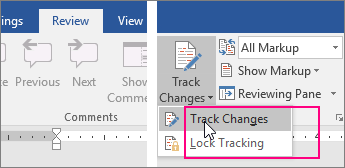

 to view two pages, or screens, at a time.
to view two pages, or screens, at a time.
